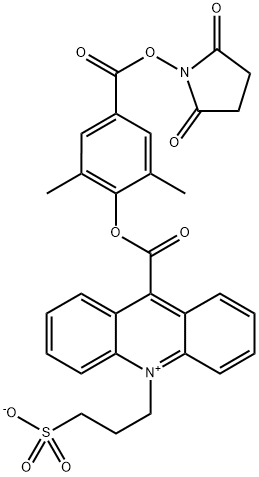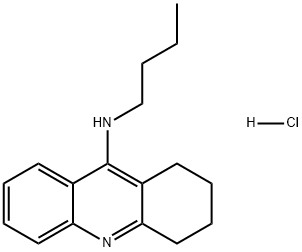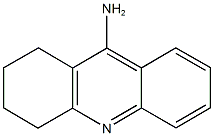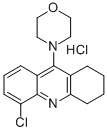TACRINE HYDROCHLORIDE
Synonym(s):9-Amino-1,2,3,4-tetrahydroacridine hydrochloride;Tacrine hydrochloride
- CAS NO.:1684-40-8
- Empirical Formula: C13H15ClN2
- Molecular Weight: 234.72
- MDL number: MFCD00012657
- EINECS: 216-867-5
- SAFETY DATA SHEET (SDS)
- Update Date: 2024-12-18 14:15:30

What is TACRINE HYDROCHLORIDE?
Description
Tacrine is the first therapeutic launched specifically for the treatment of Alzheimer's disease which affects four million people in the US alone. Clinically significant improvement in cognition has been demonstrated in the patients with Alzheimer's disease. Although the cause of Alzheimer's disease is not understood, degeneration of cholinergic neurons is thought to be a primary factor in the development and progression of the disease. Tacrine is a reversible acetylcholinesterase inhibitor that presumably acts centrally by elevating the acetylcholine level in the cerebral cortex and by slowing degradation of acetylcholine from intact cholinergic neurons. While tacrine improves the symptoms of Alzheimer's disease, the underlining cause of the dementing process is not altered. It has also been suggested that the beneficial effects of tacrine may be due to its multiple effects on several neurotransmitter systems.
Description
Tacrine was the prototypical cholinesterase inhibitor for the treatment of Alzheimer''s disease. Studies have found that it may have a small beneficial effect on cognition and other clinical measures.
Description
Tacrine is a derivative of aminoacridine that functions as an inhibitor of both acetylcholinesterase (AChE) and butyrylcholinesterase (IC50s = 31 and 26.5 nM, respectively). Tacrine also inhibits the uptake of serotonin and norepinephrine in rat cerebral cortex and decreases depolarization-induced calcium influx through L-type calcium channels in SN56 neuronal cells. Formulations containing tacrine have been used clinically in the treatment of Alzheimer’s disease.
Chemical properties
Pale Yellow Solid
Originator
NIH (U.S.A.)
The Uses of TACRINE HYDROCHLORIDE
A potent centrally acting anticholinesterase, for therapy of memory deficits in patients with Alzheimers disease. THA also selectively blocks potassium channels in the central nervous system, which results in an increased release of acetylcholi
The Uses of TACRINE HYDROCHLORIDE
anticholinesterase, cognitive adjuvant, K channel blocker
The Uses of TACRINE HYDROCHLORIDE
A potent centrally acting anticholinesterase for therapy of memory deficits in patients with Alzheimer's disease. THA also selectively blocks potassium channels in the central nervous system, which results in an increased release of acetylcholine and a prolongation of the action potential of the presynaptic cholinergic neurons.
What are the applications of Application
Tacrine Hydrochloride is an anticholinesterase (AChE) inhibitor
brand name
Cognex (Sciele).
General Description
Yellow needles (from concentrated hydrochloric acid); white powder. pH of 1.5% solution: 4.5-6. Bitter taste.
General Description
Tacrine hydrochloride,1,2,3,4-tetrahydro-9-aminoacridine hydrochloride (THA,Cognex), is a reversible cholinesterase inhibitor that hasbeen used in the treatment of Alzheimer disease for severalyears. The drug has been used to increase the levels of AChin these patients on the basis of observations from autopsiesthat concentrations of ChAT and AChE are markedly reducedin the brain, whereas the number of muscarinic receptorsis almost normal. The use of the drug is not withoutcontroversy, as conflicting results on efficacy have been reported.The drug has been used in mild-to-moderateAlzheimer dementia.
Air & Water Reactions
Water soluble.
Reactivity Profile
TACRINE HYDROCHLORIDE is incompatible with strong oxidizing agents, acid chlorides and acid anhydrides . Neutralize bases in slightly exothermic reactions.
Fire Hazard
Flash point data for TACRINE HYDROCHLORIDE are not available; however, TACRINE HYDROCHLORIDE is probably combustible.
Biological Activity
Potent cholinesterase inhibitor, a cognition enhancer in vivo .
Metabolism
Tacrine is extensively metabolized by CYP450 to at least three metabolites. The major metabolite, 1-hydroxy-tacrine, is active. Its elimination half-life is between 1.5 and 4 hours, with metabolites being are excreted via the urine.
Properties of TACRINE HYDROCHLORIDE
| Melting point: | 280-284 °C(lit.) |
| storage temp. | Inert atmosphere,2-8°C |
| solubility | Soluble in aqueous buffers |
| form | Crystalline solid |
| pka | pKa 9.8 (Uncertain) |
| color | White to light yellow |
| CAS DataBase Reference | 1684-40-8(CAS DataBase Reference) |
| EPA Substance Registry System | Tacrine hydrochloride (1684-40-8) |
Safety information for TACRINE HYDROCHLORIDE
| Signal word | Danger |
| Pictogram(s) |
 Skull and Crossbones Acute Toxicity GHS06 |
| GHS Hazard Statements |
H301:Acute toxicity,oral H302:Acute toxicity,oral H315:Skin corrosion/irritation H319:Serious eye damage/eye irritation H331:Acute toxicity,inhalation H335:Specific target organ toxicity, single exposure;Respiratory tract irritation |
| Precautionary Statement Codes |
P261:Avoid breathing dust/fume/gas/mist/vapours/spray. P304+P340:IF INHALED: Remove victim to fresh air and Keep at rest in a position comfortable for breathing. P305+P351+P338:IF IN EYES: Rinse cautiously with water for several minutes. Remove contact lenses, if present and easy to do. Continuerinsing. P405:Store locked up. |
Computed Descriptors for TACRINE HYDROCHLORIDE
New Products
(S)-3-Aminobutanenitrile hydrochloride 4-Methylphenylacetic acid N-Boc-D-alaninol N-BOC-D/L-ALANINOL Tert-butyl bis(2-chloroethyl)carbamate 3-Morpholino-1-(4-nitrophenyl)-5,6-dihydropyridin- 2(1H)-one Furan-2,5-Dicarboxylic Acid Tropic acid 1-Bromo-3,5-Di-Tert-Butylbenzene S-2-CHLORO PROPIONIC ACID ETHYL ISOCYANOACETATE 2-Bromo-1,3-Bis(Dimethylamino)Trimethinium Hexafluorophosphate 4-IODO BENZOIC ACID 3-NITRO-2-METHYL ANILINE 1-(2,4-DICHLOROPHENYL) ETHANAMINE (2-Hydroxyphenyl)acetonitrile 4-Bromopyrazole 2-(Cyanocyclohexyl)acetic acid 4-methoxy-3,5-dinitropyridine 1-(4-(aminomethyl)benzyl)urea hydrochloride 2-aminopropyl benzoate hydrochloride diethyl 2-(2-((tertbutoxycarbonyl)amino) ethyl)malonate tert-butyl 4- (ureidomethyl)benzylcarbamate Ethyl-2-chloro((4-methoxyphenyl)hydrazono)acetateRelated products of tetrahydrofuran








You may like
-
 2033-24-1 98%View Details
2033-24-1 98%View Details
2033-24-1 -
 42831-50-5 5-METHYLISOXAZOLE-4-CARBOXYLIC ACID 98%View Details
42831-50-5 5-METHYLISOXAZOLE-4-CARBOXYLIC ACID 98%View Details
42831-50-5 -
 1975-50-4 98%View Details
1975-50-4 98%View Details
1975-50-4 -
 2-HYDROXY BENZYL ALCOHOL 98%View Details
2-HYDROXY BENZYL ALCOHOL 98%View Details
90-01-7 -
 2-Chloro-1,3-Bis(Dimethylamino)Trimethinium Hexafluorophosphate 221615-75-4 98%View Details
2-Chloro-1,3-Bis(Dimethylamino)Trimethinium Hexafluorophosphate 221615-75-4 98%View Details
221615-75-4 -
 61397-56-6 CIS BROMO BENZOATE 98%View Details
61397-56-6 CIS BROMO BENZOATE 98%View Details
61397-56-6 -
 14714-50-2 (2-Hydroxyphenyl)acetonitrile 98+View Details
14714-50-2 (2-Hydroxyphenyl)acetonitrile 98+View Details
14714-50-2 -
 118753-70-1 98+View Details
118753-70-1 98+View Details
118753-70-1